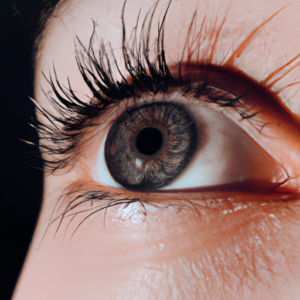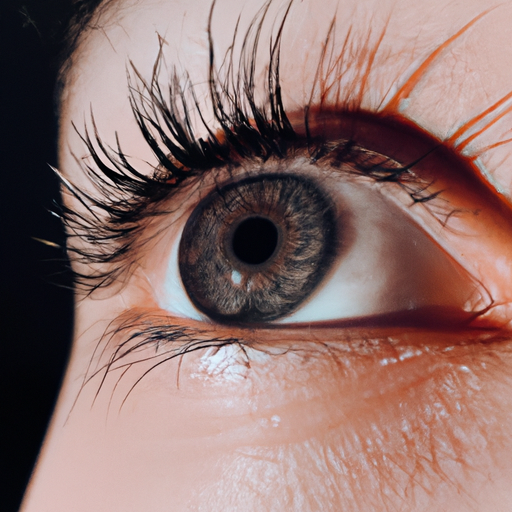I Got My Eye on You: An Introduction to Round Eyes
Hey there, peeps! Are you curious about round eyes? Have you ever wondered why some people are born with eyes that are round compared to others with almond or slanted eyes? Well, look no further because we’re about to dive deep into the world of round eyes.
First things first, let’s define what round eyes actually are. Round eyes are characterized by their circular shape with the iris being fully visible. They tend to be larger in size and have a wider opening compared to other eye shapes.
So, what makes up the anatomy of round eyes? For starters, they are located in the eye socket and are larger than other eye shapes. The iris, which is the colored part of the eye, may come in various hues such as brown, blue, or green. In terms of color distribution, some people have a more prominent limbal ring, the dark circle surrounding the iris.
Anatomy of Round EyesWelcome to my blog post about the anatomy of round eyes! So, let’s dive into it and explore this topic further.Round eyes are exactly what they sound like – eyes with a circular shape. They are typically larger in size and have a more pronounced curve in the sclera (white part of the eye) than other eye shapes. The iris (colored part of the eye) is also more visible in round eyes due to the shape of the eyelid.When it comes to color, round eyes can vary just like any other eye shape. They can be brown, blue, green, or any combination of those colors.Now, you might be wondering about the evolutionary significance of round eyes. In terms of adaptive advantages, round eyes allow for a wider field of vision which is beneficial for survival. This may be why round eyes are more commonly found in prey animals, such as rabbits and deer, because they need to be aware of their surroundings in order to evade predators.When compared to other eye shapes, like almond-shaped eyes, round eyes have a more innocent and childlike appearance. This cultural significance has led to beauty standards that prioritize large, round eyes as a desirable trait in many cultures around the world.Speaking of different cultures, it’s interesting to note that in some Asian cultures, the ideal eye shape is actually more almond-shaped, rather than round. This shows that beauty standards vary widely depending on cultural factors.Overall, the anatomy of round eyes is fascinating to explore. From their evolutionary significance to their cultural significance, there’s a lot to unpack when it comes to this eye shape.
Round Eyes: The Evolutionary Advantages
Understanding the evolutionary significance of round eyes can shed light on why this eye shape is so common in many animal species, including humans. For starters, round eyes not only provide a wider visual field, but they also allow for better depth perception, making it easier to navigate the environment and avoid potential predators. This is especially important for animals that are active during both day and night. In addition, the larger size of round eyes means that more light can enter, allowing for more visual information to be processed.
Furthermore, the placement of round eyes on the front of the face, as opposed to the sides, provides a greater overlap in the visual field of each eye, leading to better binocular vision, which is crucial for accurately judging distance and motion. This is particularly beneficial for predators that need to accurately track prey while in motion.

Interestingly, round eyes have also been found to have a close relation to other eye shapes, particularly within the primate family. This suggests that while different factors may have played a role in the evolution of certain eye shapes, they all ultimately serve the same purpose: to improve visual perception and provide a selective advantage in specific environments.
Overall, understanding the evolutionary advantages of round eyes can help us appreciate why this eye shape is so common, not just in humans, but in the animal kingdom as a whole. By providing a wider visual field, better depth perception, and improved binocular vision, round eyes have played a crucial role in the survival and success of many species, proving that evolution truly is a remarkable force.
Round Eyes: Cultural Significance
Okay, guys, let’s talk about how culture shapes our perception of round eyes and how it impacts individuals with this eye shape. Growing up, I’ve always been told that having big, round eyes is a symbol of beauty, innocence, and youthfulness. This notion is perpetuated in many cultures, including modern Western societies. Hollywood actresses with big, round eyes are oftentimes considered to be the epitome of beauty. However, it’s important to understand that not all cultures view this eye shape in the same way.
In some Asian cultures, for instance, round eyes are not as highly praised as they are in the West. In fact, in some cultures, being born with double eyelids, which create a crease in the upper eyelid, is considered to be more attractive than having round eyes. This preference for double eyelids stems from the belief that they make the eyes look bigger and alert, while creating an illusion of depth.
It’s worth noting that the cultural significance of round eyes doesn’t apply exclusively to women. Men with round eyes are also perceived differently in various cultures. In India, for example, men with big, round eyes are considered to be lucky and blessed by the gods.
Overall, the cultural significance of round eyes is a fascinating topic that sheds light on how beauty standards and cultural values can vary drastically across different regions and populations. Whether you have round eyes or not, it’s important to embrace and appreciate your unique features, regardless of what society tells you is attractive or not. After all, beauty comes in all shapes and sizes!
Final Thoughts: Wrap Up on Round Eyes
Okay, folks, let’s wrap up this round eyes discussion. To recap, we covered a lot of ground in this blog post, exploring the anatomy, evolutionary significance, and cultural significance of round eyes. But what have we learned?First, we know that round eyes are characterized by their size, location, and color. They are found in many mammals, including humans, and are often considered a desirable trait in terms of beauty standards.Secondly, we examined the evolutionary significance of round eyes and discovered the adaptive advantages of having them. We also explored the relationship between round eyes and other eye shapes.Finally, we looked at cultural significance and how round eyes are viewed across different cultures. We learned that beauty standards vary widely, and that round eyes are favored in some cultures more than others.Overall, what can we conclude from all of this? Well, it’s clear that round eyes are fascinating and complex. They have evolved for a reason and have played an important role throughout human history.If you want to learn more about eye shapes and beauty standards, check out this site: https://besteyelashextensionsupplies.com/what-is-the-most-attractive-eye-shape/. Happy reading!
